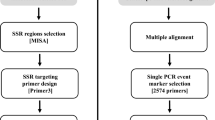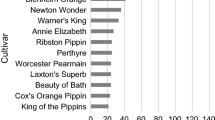Abstract
Simple sequence repeats (SSRs or microsatellites) are frequently used as a robust, rapid, and relatively inexpensive means of genotyping. Recent reports in cultivated strawberry (Fragaria × ananassa) have identified a widely applicable set of SSRs that permits discrimination of closely-related genotypes. In the present study this same set of SSRs is analyzed in cultivars commonly grown in the state of Florida, as well as advanced breeding selections from the University of Florida program. Nine primer pairs have been used to produce discrete SSR patterns for all lines tested, including diagnostic sets that distinguish between closely-related cultivars and/or breeding selections. A comparison of markers to known pedigrees is presented, along with analysis of relative relatedness between lines studied. We also detail important technical considerations for transferability and limitations of these technologies between laboratories. The resulting genotype data for cultivars commonly used in Florida are accessible as supplemental data in graphic format and allow comparison with other cultivars. Users can thus select the most diagnostic SSRs to test the lines in question. These resources provide new tools for breeders and nurseries to authenticate genotypes, follow inheritance patterns and enforce patent protection. As important, this report underscores the strengths and weaknesses of applying the original methodologies to a different plant population in independent laboratories.



Similar content being viewed by others
References
Alba V, Montemurro C, Sabetta W, Pasqualone A, Blanco A (2009) SSR-based identification key of cultivar of Olea europaea L. diffused in Southern-Italy. Sci Hortic 123:11–16
Arnau G, Lallemand J, Bourgoin M (2003) Fast and reliable strawberry cultivar identification using inter simple sequence repeat (ISSR) amplification. Euphytica 129:69–79
Ashley MV, Wilk JA, Styan SMN, Craft KJ, Jones KL, Feldheim KA, Lewers KS, Ashman TL (2003) High variability and disomic segregation of microsatellites in the octoploid Fragaria virginiana Mill. (Rosaceae). Theor Appl Genet 107:1201–1207
Bassil NV, Gunn M, Folta K, Lewers K (2006) Microsatellite markers for Fragaria from ‘Strawberry Festival’ expressed sequence tags. Mol Ecol Notes 6:473–476
Buteler MI, Jarret RL, LaBonte DR (1999) Sequence characterization of microsatellites in diploid and polyploid Ipomoea. Theor Appl Genet 99:123–132
Chang S, Puryear J, Cairney J (1993) A simple and efficient method for isolating RNA from pine trees. Plant Mol Biol Rep 11:113–116
Cipriani G, Pinosa F, Bonoli M, Faedi W (2006) A new set of microsatellite markers for Fragaria species and their application in linkage analysis. J Hortic Sci Biotechnol 81:668–675
Clark JM (1988) Novel non-templated nucleotide addition reactions catalyzed by procaryotic and eucaryotic DNA polymerases. Nucleic Acids Res 16:9677–9686
Congiu L, Chicca M, Cella R, Rossi R, Bernacchia G (2000) The use of random amplified polymorphic DNA (RAPD) markers to identify strawberry varieties: a forensic application. Mol Ecol 9:229–232
Dale A, Sjulin TM (1990) Few cytoplasms contribute to North-American strawberry cultivars. HortScience 25:1341–1342
Dangl GS, Mendum ML, Prins BH, Walker MA, Meredith CP, Simon CJ (2001) Simple sequence repeat analysis of a clonally propagated species: a tool for managing a grape germplasm collection. Genome 44:432–438
Dangl GS, Woeste K, Aradhya MK, Koehmstedt A, Simon C, Potter D, Leslie CA, McGranahan G (2005) Characterization of 14 microsatellite markers for genetic analysis and cultivar identification of walnut. J Am Soc Hortic Sci 130:348–354
Dangl GS, Lee EW, Sims ST, Golino DA (2007) A new system for strawberry cultivar identification developed at Foundation Plant Services (FPS), University of California, Davis, using simple sequence repeat (SR) primers. In: NASS/NASGA proceedings, pp 118–121
Dangl GS, Yang J, Golino D, Gradziel T (2009) A practical method for almond cultivar identification and parental analysis using simple sequence repeat markers. Euphytica 168:41–48
Degani C, Rowland L, Levi A, Hortynski J, Galletta G (1998) DNA fingerprinting of strawberry (Fragaria × ananassa) cultivars using randomly amplified polymorphic DNA (RAPD) markers. Euphytica 102:247–253
Ellsworth DL, Rittenhouse D, Honeycutt RL (1993) Artifactual variation in randomly amplified polymorphic DNA binding patterns. Biotechniques 14:214–217
Folta K, Dhingra A, Howard L, Stewart P, Chandler C (2006) Characterization of LF9, an octoploid strawberry genotype selected for rapid regeneration and transformation. Planta 224:1058–1067
Garcia MG, Ontivero M, Diaz Ricci JC, Castagnaro A (2002) Morphological traits and high resolution RAPD markers for the identification of the main strawberry varieties cultivated in Argentina. Plant Breed 121:76–80
Garcia-Vallve S, Palau J, Romeu A (1999) Horizontal gene transfer in glycosyl hydrolases inferred from codon usage in Escherichia coli and Bacillus subtilis. Mol Biol Evol 16:1125–1134
Gil-Ariza DJ, Amaya I, Botella MA, Munoz BJ, Caballero JL, Lopez-Aranda JM, Valpuesta V, Sanchez-Sevilla JF (2006) EST-derived polymorphic microsatellites from cultivated strawberry (Fragaria × ananassa) are useful for diversity studies and varietal identification among Fragaria species. Mol Ecol Notes 6:1195–1197
Govan C, Simpson DW, Johnson AW, Tobutt KR, Sargent DJ (2008) A reliable multiplexed microsatellite set for genotyping Fragaria and its use in a survey of 60 F. × ananassa cultivars. Mol Breeding 22:649–661
Graham J, McNicol RJ, McNicol JW (1996) A comparison of methods for the estimation of genetic diversity in strawberry cultivars. Theor Appl Genet 93:402–406
Guilford P, Prakash S, Zhu JM, Rikkerink E, Gardiner S, Bassett H, Forster R (1997) Microsatellites in Malus × domestica (apple): abundance, polymorphism and cultivar identification. Theor Appl Genet 94:249–254
Gupta PK, Balyan IS, Sharma PC, Ramesth B (1996) Microsatellites in plants—a new class of molecular markers. Curr Sci 70:45–54
Hancock JF, Callow PA, Shaw DV (1994) Randomly amplified polymorphic DNAs in the cultivated strawberry, Fragaria × ananassa. J Am Soc Hortic Sci 119:862–864
Kuras A, Korbin M, Zurawicz E (2004) Comparison of suitability of RAPD and ISSR techniques for determination of strawberry (Fragaria × ananassa Duch.) relationship. Plant Cell Tissue Organ Cult 79:189–193
Lewers KS, Styan SMN, Hokanson SC, Bassil NV (2005) Strawberry genbank-derived and genomic simple sequence repeat (SSR) markers and their utility with strawberry, blackberry, and red and black raspberry. J Am Soc Hortic Sci 130:102–115
Lian C, Nara K, Nakaya H, Zhou Z, Wu B, Miyashita N, Davis TM (2001) Development of microsatellite markers in polyploid Salix reinii. Mol Ecol Notes 1:160–161
MacPherson JM, Eckstein PE, Scoles GJ, Gajadhar AA (1993) Variability of the random amplified polymorphic DNA assay among thermal cyclers, and effects of primer and DNA concentration. Mol Cell Probes 7:293–299
Marchese A, Tobutt KR, Caruso T (2005) Molecular characterisation of Sicilian Prunus persica cultivars using microsatellites. J Hortic Sci Biotechnol 80:121–129
Milella L, Saluzzi D, Lapelosa M, Bertino G, Spada P, Greco I, Martelli G (2006) Relationships between an Italian strawberry ecotype and its ancestor using RAPD markers. Genet Resour Crop Evol 53:1715–1720
Monfort A, Vilanova S, Davis TM, Arús P (2006) A new set of polymorphic simple sequence repeat (SSR) markers from a wild strawberry (Fragaria vesca) are transferable to other diploid Fragaria species and to Fragaria × ananassa. Mol Ecol Notes 6:197–200
Morgante M, Olivieri AM (1993) PCR-amplified microsatellites as markers in plant genetics. Plant J 3:175–182
Myakishev MV, Khripin Y, Hu S, Hamer DH (2001) High-throughput SNP genotyping by allele-specific PCR with universal energy-transfer-labeled primers. Genome Res 11:163–169
Perez T, Albornoz J, Dominguez A (1998) An evaluation of RAPD fragment reproducibility and nature. Mol Ecol 7:1347–1357
Rabouam C, Comes AM, Bretagnolle V, Humbert J, Perique G, Bigot Y (1999) Features of DNA fragments obtained by random amplified polymorphic DNA (RAPD) assays. Mol Ecol 8:493–503
Sargent DJ, Hadonou AM, Simpson DW (2003) Development and characterization of polymorphic microsatellite markers from Fragaria viridis, a wild diploid strawberry. Mol Ecol Notes 3:550–552
Sargent DJ, Clarke J, Simpson DW, Tobutt KR, Arús P, Monfort A, Vilanova S, Denoyes-Rothan B, Rousseau M, Folta KM, Bassil NV, Battey NH (2006) An enhanced microsatellite map of diploid Fragaria. Theor Appl Genet 112:1349–1359
Sarri V, Baldoni L, Porceddu A, Cultrera NGM, Frediani M, Belaj A, Trujillo I, Cionini PG (2006) Microsatellite markers are powerful tools for discriminating among olive cultivars and assigning them to geographically defined populations. Genome 49:1606–1615
Slovin JP, Schmitt K, Folta KM (2009) An inbred line of the diploid strawberry Fragaria vesca f. semperflorens for genomic and molecular genetic studies in the Rosaceae. BMC Plant Methods 5:15
Tyrka M, Dziadczyk P, Hortyński J (2002) Simplified AFLP procedure as a tool for identification of strawberry cultivars and advanced breeding lines. Euphytica 125:273–280
Acknowledgements
This research was funded by a grant from the University of Florida IFAS Dean for Research (KMF and NP). The authors thank Dr. Daniel Sargent for valuable discussions and Kayla Shea Childers for technical assistance. The authors also recognize Dr. Craig K. Chandler for helpful insights and starting materials.
Author information
Authors and Affiliations
Corresponding author
Electronic supplementary material
Below is the link to the electronic supplementary material.
Rights and permissions
About this article
Cite this article
Brunings, A.M., Moyer, C., Peres, N. et al. Implementation of simple sequence repeat markers to genotype Florida strawberry varieties. Euphytica 173, 63–75 (2010). https://doi.org/10.1007/s10681-009-0112-4
Received:
Accepted:
Published:
Issue Date:
DOI: https://doi.org/10.1007/s10681-009-0112-4




